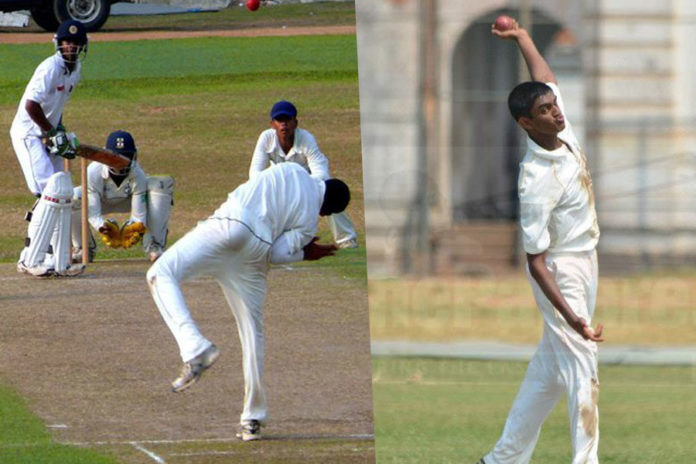Dr Ivan Fitzwater, a renowned author once said, “The future of the world is in my classroom today,” likewise, the future of Test Cricket remains in today’s schools’ cricket grounds.
We are talking of a system which began in the mid-Eighteenth Century and went on to gain acclaim as one of the best grassroot systems in the world, the system which produced the greats from Wettimuny to Ranatunga to Jayawardena. But, is it still the same? Has it got the same intensity?
Murali – The real face of Sri Lankan Cricket
If you’ve followed schools’ cricket over the past few years, you would perhaps have noticed a few areas in which the schools system is lacking. It wouldn’t be too unfair to say that the likes of Mahela Jayawardene, Thilan Samaraweera and Farveez Maharoof are among the last truly international cricket-ready cricketers produced by the system.
Lack of direction
Recently, a set of elite cricketers met the Prime Minister of Sri Lanka to discuss the announcement of plans to build a new cricket ground in Homagama. Their argument being that a new ground is not necessary and instead pointed out how poor the infrastructure of our breeding grounds is. They addressed issues like the fact that only a handful of schools have turf wickets in Sri Lanka, schools in North and North-East not having enough facilities and the lack of equipment in the majority of schools.
With all due respect, those are all issues that need attention and fixing them will certainly contribute to the betterment of the sport, but will it alone fix all the woes in Sri Lanka’s cricketing future?
To win a Test match you need to take 20 wickets, but in Sri Lankan schools’ cricket, you can win if you bat through two days, a system that encourages a defensive mindset. This is a direct result of the points-based results system which allows a team to gain a ‘win’ by just ending the game with a first-innings surplus. So, of course, this is what teams target.
The first innings win becomes a priority for coaches, while gaining an outright win is an afterthought and then we complain about Sri Lanka’s lack of aggressive intent in international cricket.
A couple of decades ago there was no designated tournament in the schools’ first XI cricket arena. All the games played were traditional friendly matches and the driving force behind competition between schools was simply to improve their respective games. With traditional rivalries on show, the games were competitive teams played to win, not to draw and certainly, losing was never an option.
But that system too had its own drawbacks. Cricket was limited to the elites in the scene. Tiny schools and their players didn’t have the opportunity to grab the limelight. That is why a structured tournament was needed.
Today, in the schools U19 cricket tournament, every outright win by an innings is worth 14 points, outright wins by runs/wickets are worth 12 points, first-innings wins gain 7 points, 10 points for ties and 2 points if neither team makes a surplus in the first innings. Apart from this, points are awarded for individual performances.
It would be a daunting task to define winners if the points system is abolished. But, as a remedy, the incentives for an outright win should be substantially high and points for a first-innings win should be reduced.
Lack of leadership
Back in the day, schoolboys didn’t have coaches instructing them on every single move in a match. From how to carry themselves to how to compete on the pitch, the instructions needed to players was given during practice, once players entered the pitch, it was all up to them. There were times when coaches did not even show up for the games. Practice too was mostly a commitment the coaches made where they dropped in for a few hours after their regular job. This meant the cricketers were pretty much on their own. If the coach picked the playing eleven, the captain and the seniors took on the job from thereon.
Striking a balance between providing guidance and also allowing independent thinking, the system gave Sri Lanka a set of players with exceptional character and great leadership.
The situation is different today. Players don’t even have to write their own names on a team card. It seems like coaches are the ones who run everything during a match, with players not being given the reins. It’s not uncommon to see coaches, even former Test Cricketers who are coaches now, prowling along the boundary line in games, shouting out instructions to players. Certainly not an encouraging sight.
The beauty of Test Cricket is in those mind games you play. The tactics that are used, the changes that are made from the 1st to the last session, the thinking and outthinking of the opponent. If the kids aren’t given the freedom to think when on the field, what does that translate into when it comes time for them to graduate to the big stage?
Forgotten ODI innings from the 90s
One can argue that two days isn’t enough to produce results in every game. But, it is more than enough time to play some competitive cricket, IF the intent is there. There was a time when games began at 12noon and still produced results at a higher rate than at present. Teams even declared with deficits because the thinking was that it was better to losing going for a win than play for a draw.
Trishaw driver’s son set to conquer Lord’s
Perhaps that kind of cricket will not teach players to survive a Test match, but it will give them the aggressive mindset and courage needed to win a Test match. The skills to draw a game can be taught but not the character needed to play with intent has to be learned.
The coaches’ dilemma
In the past, coaching wasn’t an around-the-clock responsibility. Every coach had their means of income covered through other avenues. Today, with the growth of the game’s intensity and popularity, the job demands more time, energy, knowledge and dedication, needing a full-time commitment.
But, unfortunately, from present-day coaches’ job security is a major issue, most aren’t even assured of holding on to a position for consecutive seasons. They can’t afford to risk losing too many games trying to win. They can’t be experimenting with underperforming kids. They can’t cultivate a team culture and wait till the team buys into it to build character, all thanks to the prevailing hire-and-fire mentality. Naturally, most coaches concern themselves with the here and now, not really thinking of building for the future.
These are the most important aspects of our nursery that need immediate changes. Without adding value to these areas, no amount of training or planning will lift the standards of our Test team.
If this beloved version of the game is to be sustained globally it’s important that every country makes sure that the kid holding a bat for the first time falls in love with Test Cricket along the way. It’s time for Sri Lanka to do its part.


















